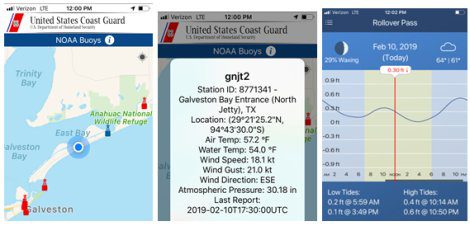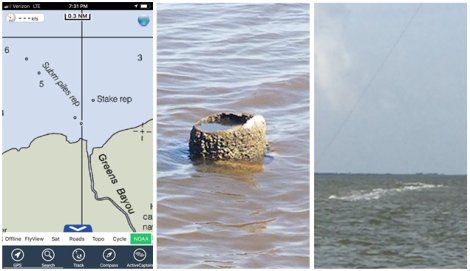 By Bob Currie, Recreational Boating Safety Specialist
By Bob Currie, Recreational Boating Safety Specialist
U. S. Coast Guard Auxiliary Station Galveston Flotilla
At the end of the first Star Trek movie, Captain Kirk said, “Mr. Sulu, ahead, warp one.” Sulu said, “Warp one, sir.” Chief DiFalco asked, “Heading, sir?” Kirk answered, “Out there. Thataway.” This may be why they seemed to get into trouble every week. They didn’t have a safe and planned course. In the popular song by Styx, the singer instructs, “set an open course for the virgin sea.” While all this sounds romantic, prudent safe boaters set a safe course. This doesn’t mean that you should never venture into new territory. Rather, it means you should set a course only after you have studied the area to which you plan to navigate and prepare your boat, your passengers and yourself for the trip. This column will be about what you need to do in order to set a safe course.
Prepare Your Boat
You should have a checklist, and you should inspect your boat to be sure it is ready for the trip. Attention to the following items is key to setting a safe course:
- Safety Equipment
You must have a life jacket on board for each person. Life jackets must be Coast Guard-approved, in serviceable condition, and the appropriate size for the intended user. Obviously, they are most effective when worn. On a vessel underway, children under 13 must wear an appropriate Coast Guard-approved life jacket unless they are below decks or in an enclosed cabin. Additionally, a boat 16 feet in length or greater, except canoes and kayaks, must have a throwable flotation device. Check your fire extinguishers too. Check your Visual Distress Signals- are your flares or rockets expired?
Additionally, a boat 16 feet in length or greater, except canoes and kayaks, must have a throwable flotation device. Check your fire extinguishers too. Check your Visual Distress Signals- are your flares or rockets expired? - Radio
 A marine FM/VHF radio is a must when you venture out onto the water. They are cheap! The walkie talkie style radios are great if you don’t want to put an antenna on your boat. Although they don’t have the range of the 25-watt mounted radios, as long as you stay within 20 miles or so of shore you can still activate the Coast Guard’s Rescue 21 system with as little as one watt.
A marine FM/VHF radio is a must when you venture out onto the water. They are cheap! The walkie talkie style radios are great if you don’t want to put an antenna on your boat. Although they don’t have the range of the 25-watt mounted radios, as long as you stay within 20 miles or so of shore you can still activate the Coast Guard’s Rescue 21 system with as little as one watt. - Fuel/Oil/Battery
The Coast Guard recommends that you follow the one third rule: one third of your fuel may be used on the outbound voyage, one third to get back, with one third to be used as a reserve. If you turn for home after using half your fuel, if your course is into the wind, you will not get back home. Know your fuel consumption at cruising speed with an average number of passengers aboard. Check your engine oil, especially if your engine is a 2-cycle. If you run out of oil on a 2-cycle engine you will burn it up. You should make sure your batteries remain fully charged during storage to prevent them from going deteriorating.
If you turn for home after using half your fuel, if your course is into the wind, you will not get back home. Know your fuel consumption at cruising speed with an average number of passengers aboard. Check your engine oil, especially if your engine is a 2-cycle. If you run out of oil on a 2-cycle engine you will burn it up. You should make sure your batteries remain fully charged during storage to prevent them from going deteriorating. - Compass/GPS
Compass/GPS: What would you do if you were a few miles from shore and the fog rolled in? Could you find your way back? Chances are, unless you had a compass or GPS, you would not be able to navigate back to shore before you ran out of fuel. If you have GPS on your boat, then great. If you don’t, you can download a GPS app on your cell phone that works quite well. Even so, you should have a compass as a backup, and know your heading when departing from shore so you can reverse your route using the compass if your GPS fails.
Chances are, unless you had a compass or GPS, you would not be able to navigate back to shore before you ran out of fuel. If you have GPS on your boat, then great. If you don’t, you can download a GPS app on your cell phone that works quite well. Even so, you should have a compass as a backup, and know your heading when departing from shore so you can reverse your route using the compass if your GPS fails.
Prepare Your Passengers
Your passengers need to be prepared for the trip. Knowledgeable passengers make the trip safer. Here are a few things to consider in order to help prepare your passengers for the trip. Let them know well in advance of where you plan to navigate.
- Float Plans
Your passengers need to know where you plan to navigate so they can file a float plan. Yes, you should file a float plan as captain, but your passengers need to let someone know where they are going and when they expect to return so they can do their own notifications. Recommend the Coast Guard smart phone app float plan to your passengers. It’s for passengers too.
Recommend the Coast Guard smart phone app float plan to your passengers. It’s for passengers too. - Weather
Your passengers need to know what kind of weather to expect so they can dress accordingly. You should always encourage your passengers to over-dress. They can always remove layers of clothing if it gets hot. - Food and Water
Remember- the Skipper and Gilligan were only supposed to be giving their passengers a 3-hour tour. You should make sure you have plenty of water and snacks for your passengers, and always have extra in case your 3-hour tour gets extended. It is the captain’s responsibility to make sure that you have sufficient water and food for your passengers. Also remember that water and alcohol do not mix. A great many of our annual boating accidents are due to or complicated by the use of alcohol. - Number of Passengers
Limit the number of persons on board to what your boat can safely carry, and be sure to consider the maximum recommended weight. Capacity plate passenger numbers are based on the hypothetical 150-pound person. Don’t overload your boat, and watch out for uninvited guests brought along by invited guests. It is hard to refuse an extra person, but you can make it clear when you invite people along that the invitation is for them only.
Capacity plate passenger numbers are based on the hypothetical 150-pound person. Don’t overload your boat, and watch out for uninvited guests brought along by invited guests. It is hard to refuse an extra person, but you can make it clear when you invite people along that the invitation is for them only.
Prepare Yourself
Before venturing out thataway, you need to be sure you as the captain are prepared both mentally and physically. Here are a few things to consider:
- Check Your Health
Don’t go out if you aren’t feeling well or are not in good shape. Your life and the lives of your passengers depend on you being fit and up to the task of being a captain. Make sure at least one passenger can take over if something happens to you, including being able to operate the boat and call for help on your marine radio. - Weather and Tides
Know the weather, including the tides for the area. If you launch on a high tide, you may have trouble getting back on a low tide, depending on the area in which you plan to navigate. There are some good weather and tide apps for your smart phone. The Coast Guard app has links to NOAA weather buoys, and if you click on a buoy, it gives you the current conditions around that buoy.
- Area Familiarization
Know the area in which you plan to operate. Yes, you can go where you have never gone before, but I don’t recommend going where no one has gone before. Instead, before going to an area new to you, find out as much as you can about the area. Ask fellow boaters who are familiar with the area. By all means, be sure to study a chart of the area, especially paying attention to underwater structures such as pilings, which are often just below the surface at high tide. An onboard GPS loaded with the chart for the area you intend to navigate can be quite helpful, but be sure to review the chart and check your route on the GPS to avoid dangerous areas. Some GPS units allow you to lay out your intended route in advance. That said, be sure to post a lookout to observe for any dangers. The lookout is the only person whose job is spelled out and whose position is required by the regulations. Be sure your new adventure does not take you into a restricted area. Restricted areas are marked on all charts, and signs are posted on or near shore advising you to stay out. We have plenty of restricted areas in our nearby waters. Pay special close attention to submerged hazards identified on your charts, especially items which may be submerged just below the surface. Not all are manmade. The frothy looking area in the picture below is an oyster shoal out in the middle of Galveston East Bay. It will take the bottom out of your boat if you hit it at speed. Sometimes it is just below the water, and sometimes it is visible.
The lookout is the only person whose job is spelled out and whose position is required by the regulations. Be sure your new adventure does not take you into a restricted area. Restricted areas are marked on all charts, and signs are posted on or near shore advising you to stay out. We have plenty of restricted areas in our nearby waters. Pay special close attention to submerged hazards identified on your charts, especially items which may be submerged just below the surface. Not all are manmade. The frothy looking area in the picture below is an oyster shoal out in the middle of Galveston East Bay. It will take the bottom out of your boat if you hit it at speed. Sometimes it is just below the water, and sometimes it is visible.
Summary
While boldly going where no person has gone before is a romantic idea, it is not a practical or safe idea. Instead, if you wish to go where you have never gone before, plan your route in advance, and set a safe course using the recommendations above.
For more information on boating safety, please visit the Official Website of the U.S. Coast Guard’s Boating Safety Division at www.uscgboating.org. SAFE BOATING!
[Aug-30-2022]

 Posted in
Posted in 























